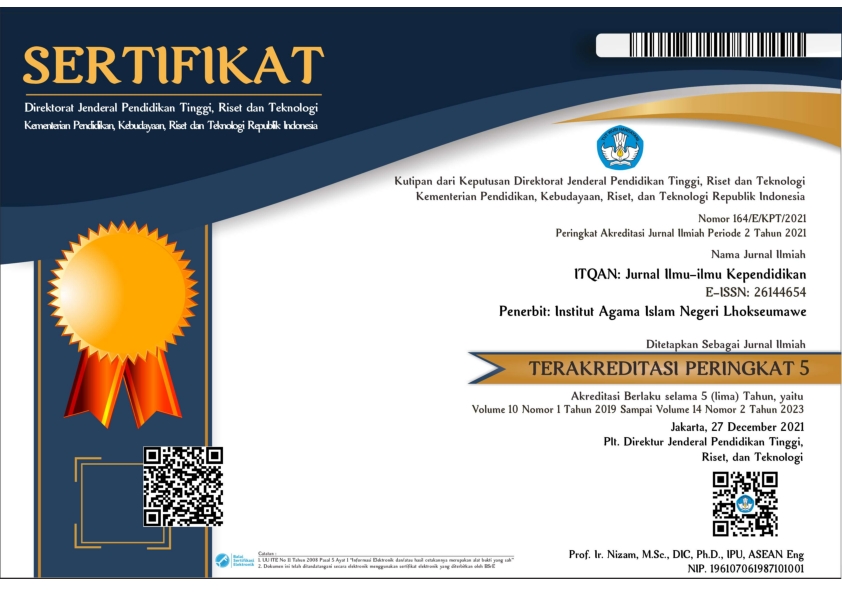The Contribution of Metaphor to Islamic Education Learning
Main Article Content
M. Nazar
This study was conducted as an attempt to show that the Qur'an was revealed by using a high, charming, and touching language style through one of the grammatical elements, namely the metaphorical style. This study uses library research. The analysis is carried out by referring to the sciences of Indonesian grammar, Arabic, and Arabic-English Dictionary Quranic Usage: Handbook of Oriental Studies by Elsaid M. Badawi and Muhammad Abdel Haleem. Then some verses of the Qur'an are taken as examples of metaphors. This study found that the Qur'an as a competency learned in Islamic religious education (Pendidikan Agama Islam/PAI) learning has many metaphorical elements that are less aware of its existence. The metaphorical style of language becomes one of the tools to translate the Qur'an properly and correctly.
Al-Hasyimi, A. (1994). Jawahir al-Balaghah fi al-Ma’ani wa al-Bayan wa al-Badi’. Dar al-Fikr.
Al-Jarim, A., & Amin, M. (1977). Al-Balaghah al-Wadhihah. Dar al-Ma’rifah.
Arikunto, S. (2016). Prosedur Penelitian Suatu Pendekatan Praktik.
Badawi, A.-S. M., & Haleem, M. A. A. (2008). Arabic-English dictionary of Qurʾanic usage (Vol. 85). Brill.
Classe, O. (Ed. . (2000). Encyclopedia of Literary Translation into English (2nd ed.). Fitzroy Dearborn Publishers.
Gorys Keraf, D. (2009). Diksi dan gaya bahasa. Gramedia Pustaka Utama.
Harahap, E. M., Parapat, L. H., & Sari, L. (2018). HUBUNGAN PENGUASAAN GAYA BAHASA METAFORA DENGAN KETERAMPILAN MENULIS NASKAH PIDATO EKSTEMPORAN. LINGUISTIK: Jurnal Bahasa Dan Sastra, 3(2), 99–113.
Husaini, H. (2021). Eksistensi Guru Pendidikan Agama Islam dalam Proses Pembelajaran pada Masa Pandemic Covid-19 di Kota Lhokseumawe. ITQAN: Jurnal Ilmu-Ilmu Kependidikan, 12(2), 299–322.
Izham, S. S., Yusoff, M., & Yakub, M. (2012). Penggunaan gaya bahasa metafora dalam Al-qur’an: Satu tinjauan awal.
Kovecses, Z. (2002). Metaphor: A Practical Introduction. Oxford Univ. Press Inc.
Lakoff, G., & Johnson, M. (1980a). Conceptual Metaphor in Everyday Language. The Journal of Philosophy, 77(8), 453–486.
Lakoff, G., & Johnson, M. (1980b). Metaphors We Live By (U. of C. Press (ed.)).
Lasyin, A. F. (n.d.). Al-Bayan fi Dhawi Asalib al-Qur’an al-Karim. Dar al-Fikr al-‘Arabi.
Leezenberg, M. (2001). Contexts of Metaphor. Elsevier.
Moleong, L. . (2002). Metode Penelitian Kualitatif. Remaja Rosdakarta.
Picken, J. D. (2007). Literature, Metaphor, and the Foreign Language Learner. Palgrave Macmillan.
Quran in English: Super Easy to Read For ages 9 to 99. (n.d.). https://www.clearquran.org
Rahayu, M. (2009). Analisis Gaya Bahasa Metafora pada Tetralogi Novel karya Andrea Hirata. Universitas Muhammadiyah Surakarta.
Richards, I. A. (1936). The Philosophy of Rhetoric. Oxford University Press.
Searle, J. R. (1981). Expression and Meaning: Studies in the Theory of Speech Acts. Cambridge University Press.
Sihotang, N. (2004). Sikap Al-Qur’an terhadap Sastra: Prinsip Dasar Sastra Islam. Julisa: Faculty of Literature UISU Medan, 4(2).
Sugiyono. (2015). Metode Penelitian; Kuantitatif, Kualitatif dan R&D. Alfabeta.
Suhadi, J. (2011). METAPHOR AS A STYLISTIC DEVICE OF ISLAMIC TEACHING. MIQOT: Jurnal Ilmu-Ilmu Keislaman, 35(1). https://doi.org/10.30821/miqot.v35i1.139
Syahrizal, S., & Hasan, F. (2021). Kompetensi Guru PAI Alumni Jurusan Pendidikan Agama Islam Fakultas Tarbiyah dan Ilmu Keguruan IAIN Lhokseumawe di Sekolah dan Madrasah di Kabupaten Aceh Utara. ITQAN: Jurnal Ilmu-Ilmu Kependidikan, 12(2), 273–288.
Thagard, P., & Beam, G. (2004). Epistemology of Metaphors and the Nature of Philosophy. Blackwell Publishing Ltd.



